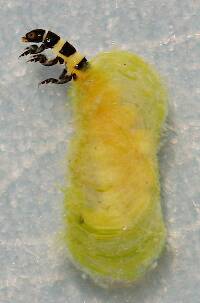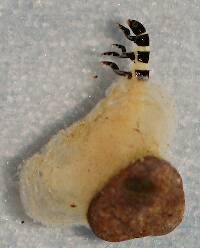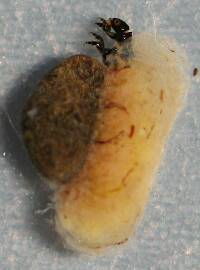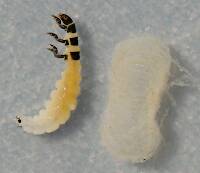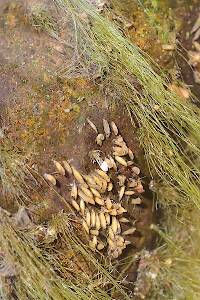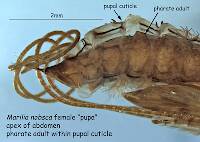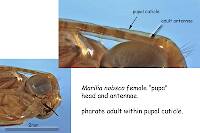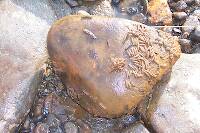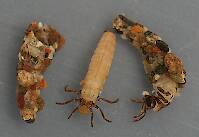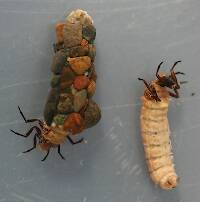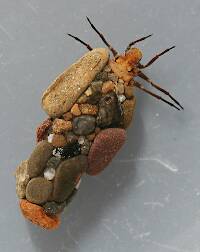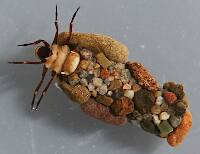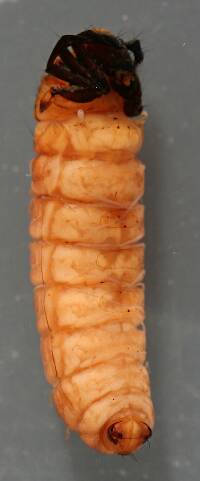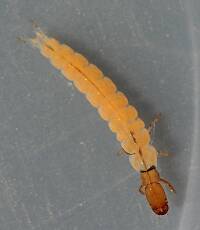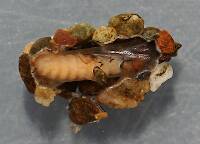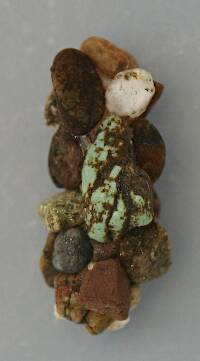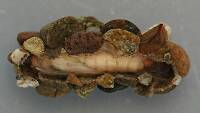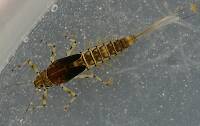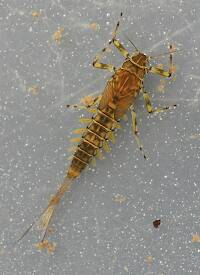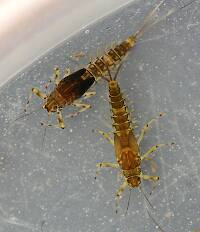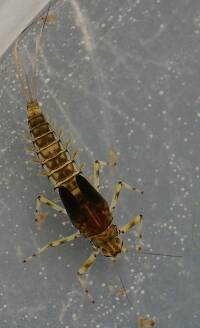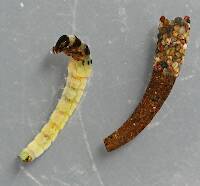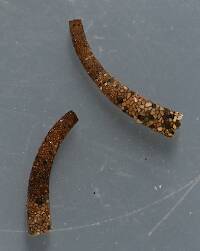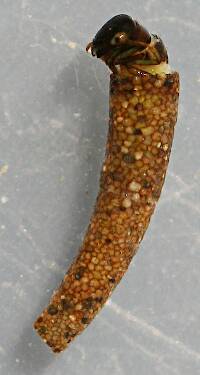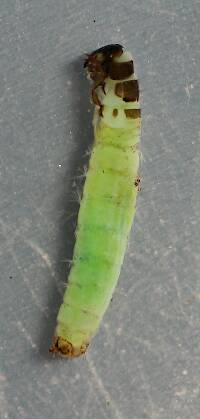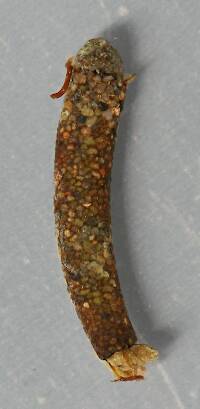
Hex Mayflies
Hexagenia limbata
The famous nocturnal Hex hatch of the Midwest (and a few other lucky locations) stirs to the surface mythically large brown trout that only touch streamers for the rest of the year.
Featured on the forum

This specimen keys pretty easily to Onocosmoecus, and it closely resembles a specimen from Alaska which caddis expert Dave Ruiter recognized as this genus. As with that specimen, the only species in the genus documented in this area is Onocosmoecus unicolor, but Dave suggested for that specimen that there might be multiple not-yet-distinguished species under the unicolor umbrella and it would be best to stick with the genus-level ID. I'm doing the same for this one.

Troutnut is a project started in 2003 by salmonid ecologist Jason "Troutnut" Neuswanger to help anglers and
fly tyers unabashedly embrace the entomological side of the sport. Learn more about Troutnut or
support the project for an enhanced experience here.
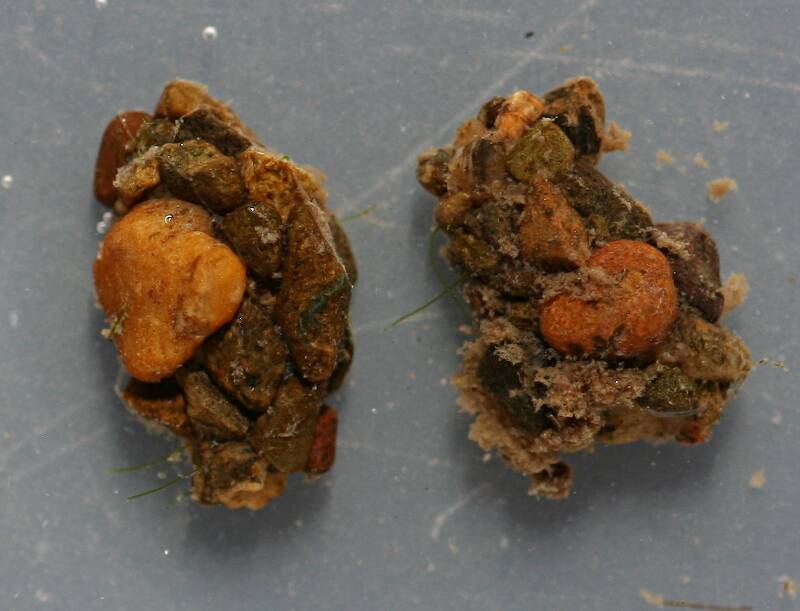
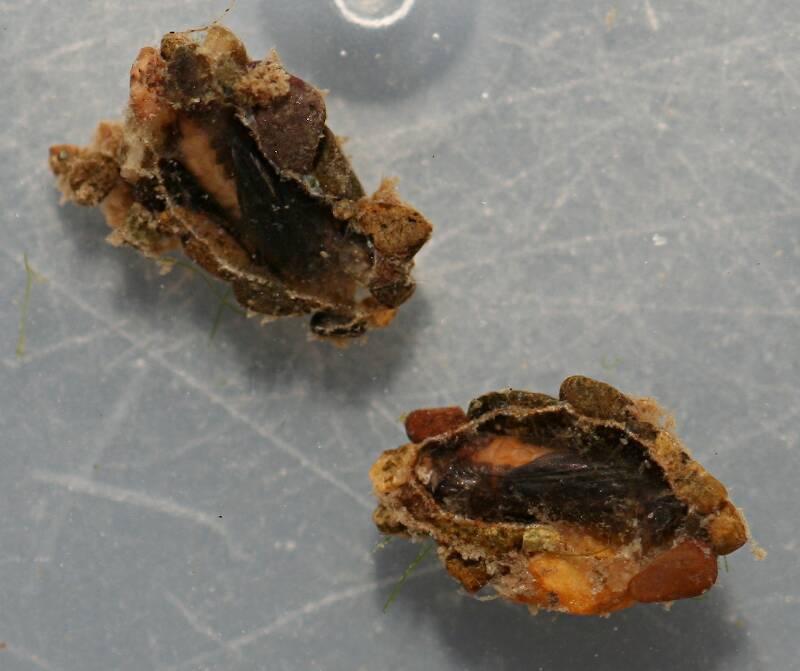

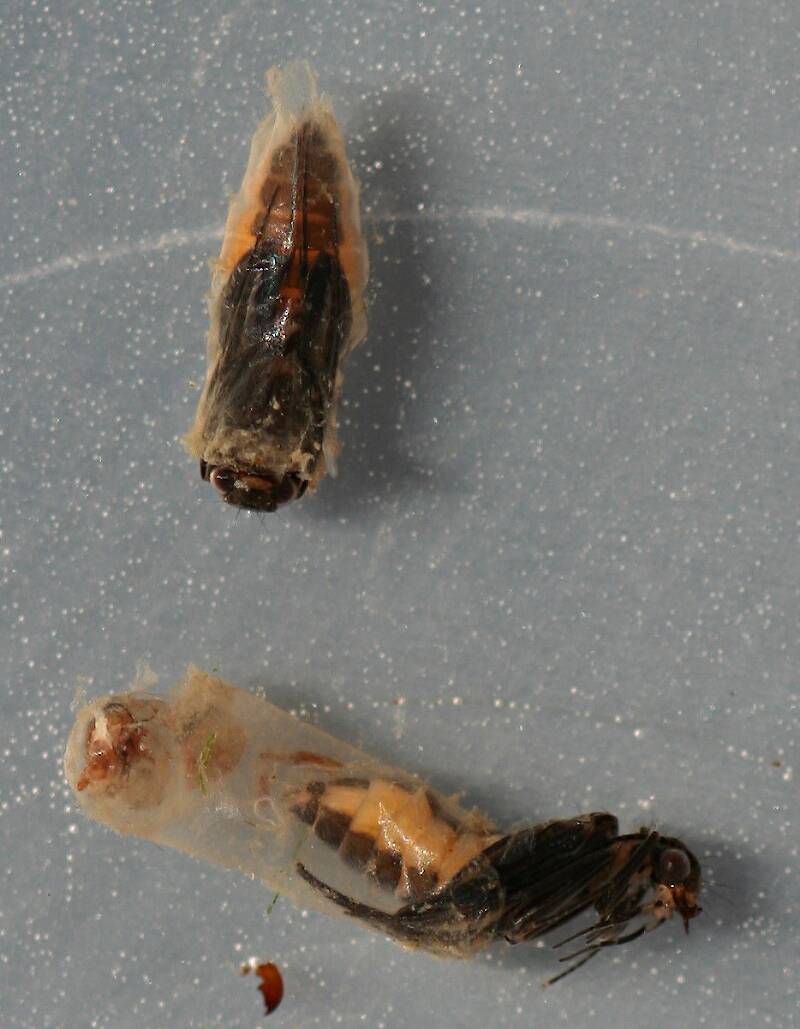
Millcreek on Sep 30, 2014September 30th, 2014, 4:15 pm EDT
The Chimarra emergences on the Russian River are tapering off now but there are still a lot of larvae and pupal cases to be found. Took these pictures of live pupae earlier today. Look like they were just about ready to emerge.
"If we knew what it was we were doing, it would not be called research, would it?"
-Albert Einstein
-Albert Einstein
Oldredbarn on Sep 30, 2014September 30th, 2014, 4:35 pm EDT
Great stuff! Nice to get a peek at the sheath that surrounds them. We have heard a great deal about them.
Brother, you are blowing some minds here...Wonderful pics.
Spence
Brother, you are blowing some minds here...Wonderful pics.
Spence
"Even when my best efforts fail it's a satisfying challenge, and that, after all, is the essence of fly fishing." -Chauncy Lively
"Envy not the man who lives beside the river, but the man the river flows through." Joseph T Heywood
"Envy not the man who lives beside the river, but the man the river flows through." Joseph T Heywood
Millcreek on Sep 30, 2014September 30th, 2014, 4:58 pm EDT
Thanks, Spence. I enjoy seeing the little buggers and photographing them. Wish I'd had a video camera with a macro lens today. The pupae were really moving around a lot in a sinuous way and it would have been interesting to capture that on film.
About as close as I get to a psychedelic experience these days.
Brother, you are blowing some minds here...Wonderful pics.
About as close as I get to a psychedelic experience these days.
"If we knew what it was we were doing, it would not be called research, would it?"
-Albert Einstein
-Albert Einstein
Jmd123 on Sep 30, 2014September 30th, 2014, 4:58 pm EDT
"Brother, you are blowing some minds here...Wonderful pics."
I second that motion!
Jonathon
I second that motion!
Jonathon
No matter how big the one you just caught is, there's always a bigger one out there somewhere...
Martinlf on Sep 30, 2014September 30th, 2014, 6:51 pm EDT
And I third it. Thank you!
"He spread them a yard and a half. 'And every one that got away is this big.'"
--Fred Chappell
--Fred Chappell
Millcreek on Sep 30, 2014September 30th, 2014, 6:57 pm EDT
Jonathan and Lewis- Thanks and don't worry, I've got enough photos of different species that you'll be begging me to quit posting them after awhile:).
"If we knew what it was we were doing, it would not be called research, would it?"
-Albert Einstein
-Albert Einstein
Taxon on Sep 30, 2014September 30th, 2014, 9:54 pm EDT
Jonathan and Lewis- Thanks and don't worry, I've got enough photos of different species that you'll be begging me to quit posting them after awhile:).
Well Mark, can't speak for Jonathan or Lewis, but you are unlikely find me begging for you to quit posting your fantastic photos. :-)
Feathers5
Posts: 287
Posts: 287
Feathers5 on Oct 1, 2014October 1st, 2014, 5:58 am EDT
I fourth that sentiment. So, that's the sheath that La Fontaine is trying to emulate?
Millcreek on Oct 1, 2014October 1st, 2014, 7:40 am EDT
Roger-
Be careful what you wish for.:)
Feathers5-
I'm not sure that's what La Fontaine was describing. These pupae hadn't emerged from the case on their own, I'd popped them out of the cases to get more detail. I suspect that the silken cocoons or sheaths probably remain in the stone case when they emerge (or not, I'm not positive). If Creno sees this thread perhaps he can shed some more light on this. The pupae do have a larval cuticle around them that doesn't show well in these photos but has a bit of a shine to it. An example can be seen here in an excellent photo submitted by Creno http://www.troutnut.com/topic/6818/Pupal-exuvia-pics#32485. There are also some photos of a Hydropsychid pupae emerging by Paul Roberts here: http://www.troutnut.com/topic/2516/Caddis-Pupae-Question You'll have to scroll down the thread a ways to see the photos.
Well Mark, can't speak for Jonathan or Lewis, but you are unlikely find me begging for you to quit posting your fantastic photos. :-)
Be careful what you wish for.:)
Feathers5-
I'm not sure that's what La Fontaine was describing. These pupae hadn't emerged from the case on their own, I'd popped them out of the cases to get more detail. I suspect that the silken cocoons or sheaths probably remain in the stone case when they emerge (or not, I'm not positive). If Creno sees this thread perhaps he can shed some more light on this. The pupae do have a larval cuticle around them that doesn't show well in these photos but has a bit of a shine to it. An example can be seen here in an excellent photo submitted by Creno http://www.troutnut.com/topic/6818/Pupal-exuvia-pics#32485. There are also some photos of a Hydropsychid pupae emerging by Paul Roberts here: http://www.troutnut.com/topic/2516/Caddis-Pupae-Question You'll have to scroll down the thread a ways to see the photos.
"If we knew what it was we were doing, it would not be called research, would it?"
-Albert Einstein
-Albert Einstein
Creno on Oct 1, 2014October 1st, 2014, 9:17 am EDT
Folks - there is an excellent discussion of the various types of pupal cocoons in Wiggins 2004 (Caddisflies: the underwater architects. Toronto, University of Toronto Press). In summary of Wiggins 2004, the cocoon of Chimarra remains attached to the pupal enclosure and substrate. Lafontaine was probably talking about the pupal integument. You can think of the various layers starting from the stream substrate and proceeding inward to the developing adult as: 1:substrate, 2: rocks (in the philopotamids, a dome with the bottom open to the stream substrate), 3: cocoon (a silken sack within the dome, in the philopotamids is is attached via silk to the dome and the substrate), 4: pupal integument (outer layer of pupae - which you can see in Millcreek's referenced pics as it separates from the adult integument) 5: adult integument. All these layers develop from the larvae which builds the dome on the substrate, and spins the cocoon. The larvae then transforms to the pupae while shedding the larval integument and moving the hard larval parts to the back of the case. The pupae then transforms to the adult within the pupal integument and exits the dome where the final transformation occurs as the adult sheds the pupal integument. This larval/pupal develop process with with all the construction, spinning, and transforming is a major investment of energy without addition food intake and the reason why the adults can be much smaller than mature larvae.
Millcreek on Oct 1, 2014October 1st, 2014, 7:35 pm EDT
Dave- Thanks for the explanation of the components of the pupal case. Amazing how much goes on in the lives and behaviors of these animals.
"If we knew what it was we were doing, it would not be called research, would it?"
-Albert Einstein
-Albert Einstein
Entoman on Oct 1, 2014October 1st, 2014, 10:14 pm EDT
Ditto Taxon's comments, Mark.
Bruce-
In laymen's terms (anglerspeak) what the photos show are pupae being removed from their shelter linings. Their pupal "skins" are still in place. The stage that anglers are concerned with according to the groundbreaking work (angler perspective) of LaFontaine is when the pupae are preparing to shed their pupal skins to become pharate adults. There has been some debate as to the relative shininess of this stage and whether the space under the exuvia is occupied by gas or liquid. My personal belief is that it is fluid and that this stage is less "shiny" than currently assumed by most anglers because of adjectives attached to pupal patterns. The words "shiny" or "sparkly" are best reserved for the adult stages of those species whose returning egg layers dive carrying air bubbles with them.
Bruce-
In laymen's terms (anglerspeak) what the photos show are pupae being removed from their shelter linings. Their pupal "skins" are still in place. The stage that anglers are concerned with according to the groundbreaking work (angler perspective) of LaFontaine is when the pupae are preparing to shed their pupal skins to become pharate adults. There has been some debate as to the relative shininess of this stage and whether the space under the exuvia is occupied by gas or liquid. My personal belief is that it is fluid and that this stage is less "shiny" than currently assumed by most anglers because of adjectives attached to pupal patterns. The words "shiny" or "sparkly" are best reserved for the adult stages of those species whose returning egg layers dive carrying air bubbles with them.
"It's not that I find fishing so important, it's just that I find all other endeavors of Man equally unimportant... And not nearly as much fun!" Robert Traver, Anatomy of a Fisherman
Crepuscular on Oct 2, 2014October 2nd, 2014, 9:57 am EDT
My personal belief is that it is fluid and that this stage is less "shiny" than currently assumed by most anglers because of adjectives attached to pupal patterns. The words "shiny" or "sparkly" are best reserved for the adult stages of those species whose returning egg layers dive carrying air bubbles with them.
My observations support what you are saying Kurt. Personally I'm pretty much anti flash when it comes to most of my imitations, when you see those pupal exuviae hanging off the back a a pharate adults it looks more like a thin plastic bag than a "sparkly bubble"in my opinion.
Millcreek on Oct 2, 2014October 2nd, 2014, 11:52 am EDT
Kurt and Eric - I think you're right. I've seen a fair number of pupae and never noticed any air trapped between the pharate adult and the pupal integument. Any shiny reflection associated with the pupae has been minimal and seems associated with light reflecting off the pupal integument. I think Eric's description of the pupal exuvia looking like a thin plastic bag is correct. I also think Kurt is correct in assuming that the space under the exuvia is filled with fluid.
"If we knew what it was we were doing, it would not be called research, would it?"
-Albert Einstein
-Albert Einstein
Quick Reply
Related Discussions
Topic
Replies
Last Reply
8
Aug 25, 2014
by Millcreek
by Millcreek
4
Oct 29, 2014
by Millcreek
by Millcreek








